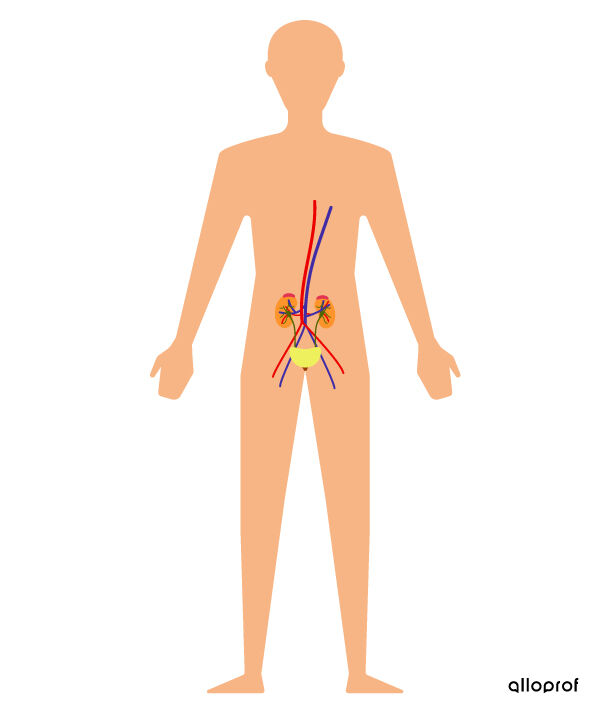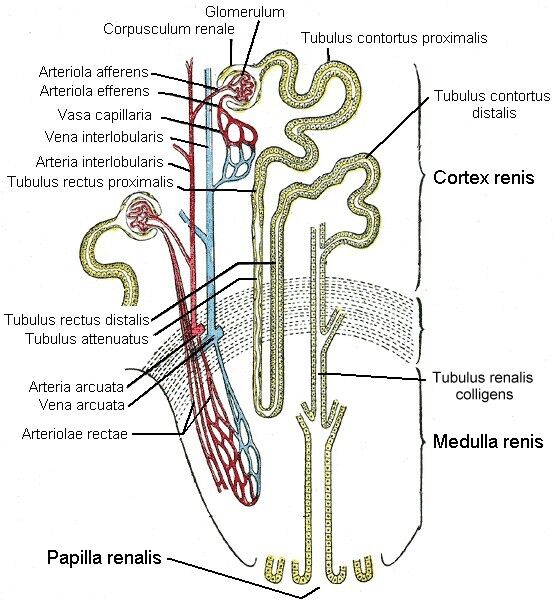The excretory system is the set of organs involved in excretion. This system consists primarily of the urinary system, but also includes the respiratory system and the sweat glands.
The human body must dispose of harmful substances and waste on a daily basis, since these substances can become toxic. For example, when cells use nutrients from carbohydrates and fats, they produce carbon dioxide |\text{CO}_2),| and when they use nutrients from proteins, they produce nitrogenous waste products (e.g., urea) during cellular respiration. If substances, such as minerals or certain vitamins, become too concentrated in the bloodstream, they are treated as waste due to their excess in the body.
To get rid of this waste and maintain a balanced metabolism, known as homeostasis, the excretory system comes into play. This system is mainly composed of the urinary system which filters the blood, but the respiratory system and the sweat glands also play a role.


-
Organs of the human urinary system
-
Kidney
-
Renal pelvis
-
Ureter
-
Bladder
-
Urethra
-
Adrenal gland
-
Renal artery (red) and renal vein (blue)
-
Inferior vena cava
-
Aorta
-
Common iliac artery (red) and common iliac vein (blue)
-
Liver
-
Large intestine
-
Pelvis
The urinary system only includes a few organs:
This system has two interrelated functions. First, it filters the blood to collect urea, other nitrogenous waste products and excess substances present in the blood (water and minerals). Secondly, it’s responsible for disposing of this waste through excretion.
The most important organs in the excretory system are the kidneys. Each person has two kidneys that filter the blood. They’re located under the bottom ribs, towards the back of the body, on either side of the spinal column and resemble dark red beans. Each kidney consists of millions of small filtering units called nephrons. Blood enters each kidney through a renal artery and flows through the capillary bed surrounding each nephron. This process removes nitrogenous waste (urea and others) and excess substances, such as water and minerals. The collected substances form urine. The filtered blood leaves the urinary system through the renal vein.
A nephron in detail

A nephron consists of a renal corpuscle and a renal tubule. Nephrons are highly vascularized (surrounded by blood vessels) to ensure that a large portion of the blood is filtered. The non-cellular elements that make up the blood, such as electrolytes, water, urea and other small molecules, pass from the blood capillaries into the lumen (inner space) of the renal corpuscle and renal tubules. One of the main functions of the renal tubules is to reabsorb water and |\text{NaCl}| (salt). The liquid contained in these tubules is called filtrate and is transformed into urine after dilution or concentration of the urea and other waste. The urine formed is excreted by the kidney through the renal collecting tubule to the ureter and then to the bladder. One of the important structures in nephrons are the nephron loops. They conserve water by producing hypertonic urine, which is over-concentrated in electrolytes and urea compared to other body fluids, such as interstitial fluid or blood. The capillary system associated with the nephron loop is called the vasa recta.
The ureters are simply ducts connecting the kidneys to the bladder and their only function is to carry urine from the kidneys to the bladder.
The bladder is an expandable reservoir that collects urine before it is released. There is a circular muscle, called a sphincter, at the base of the bladder that, when contracted, prevents urine from flowing involuntarily through the urethra.
The urethra is the tube that connects the bladder to the outside of the body. When the bladder is full, urination is triggered. This action consists of expelling urine through the urethra. In female bodies, the urethra is between 3 cm and 4 cm long and the opening is near the vaginal opening. In male bodies, the urethra is about 20 cm long, since the urine must pass through the penis before being expelled.